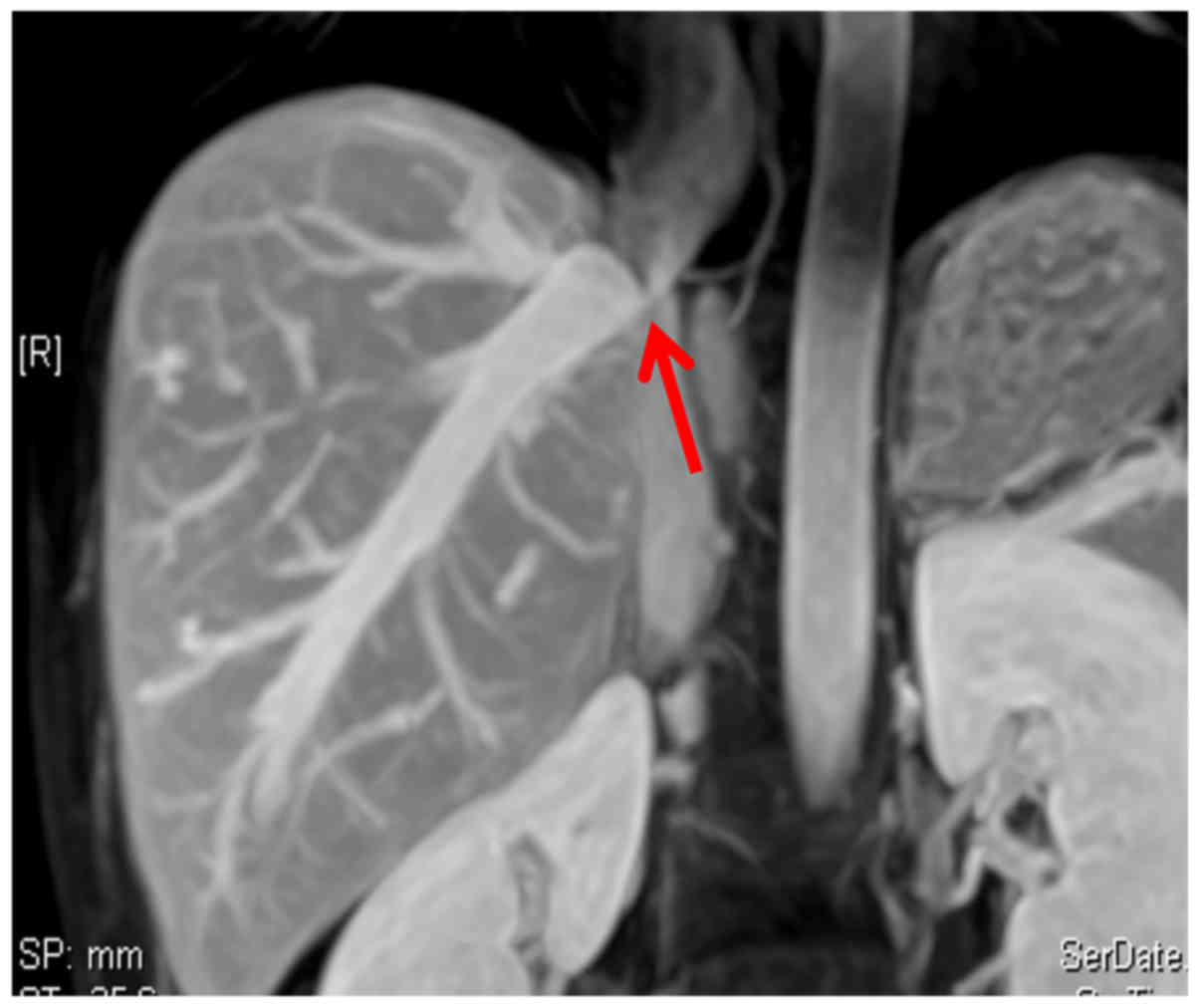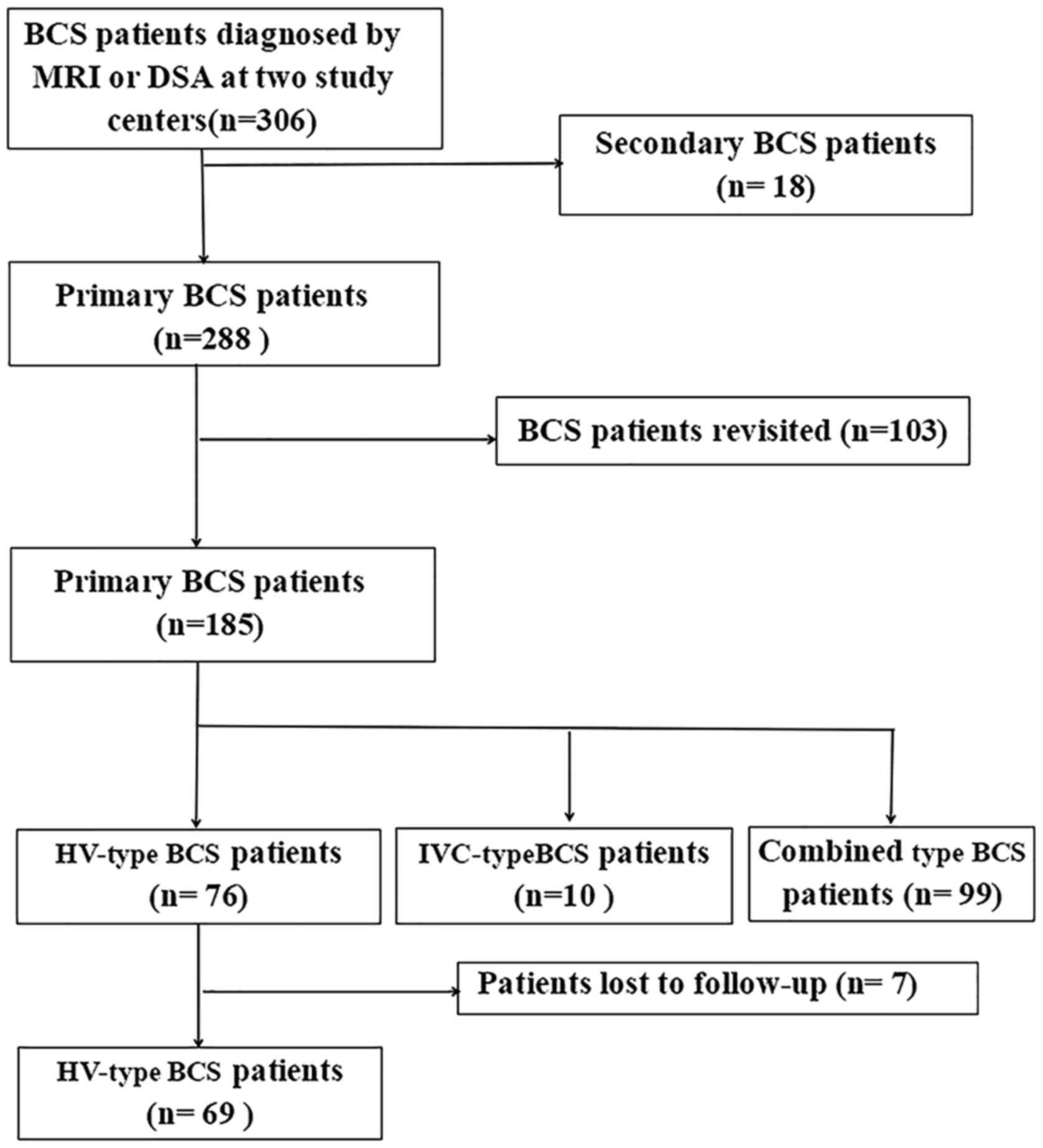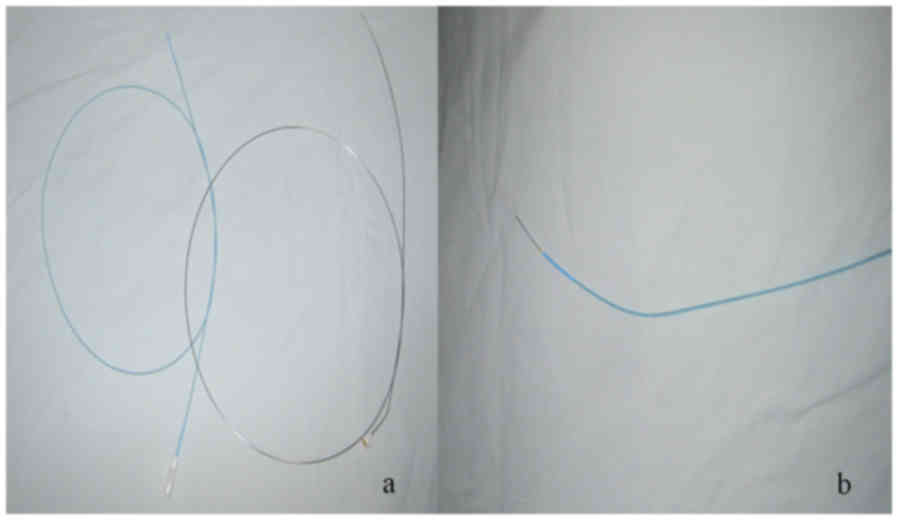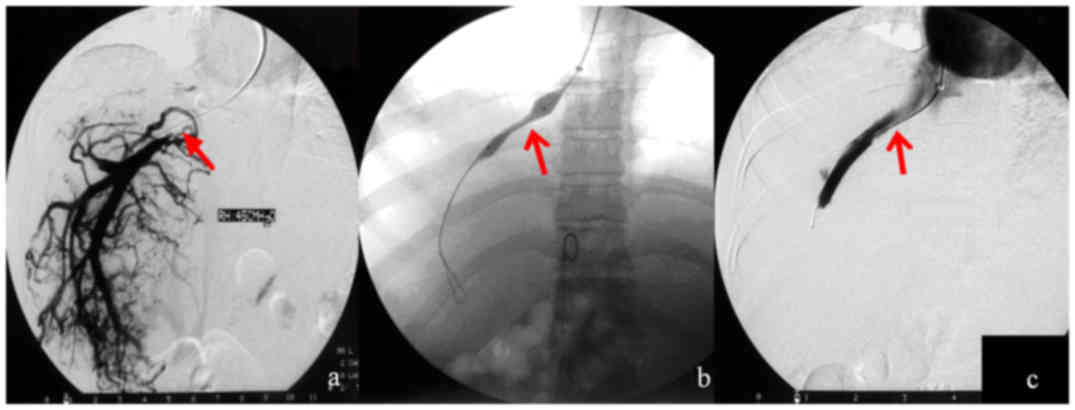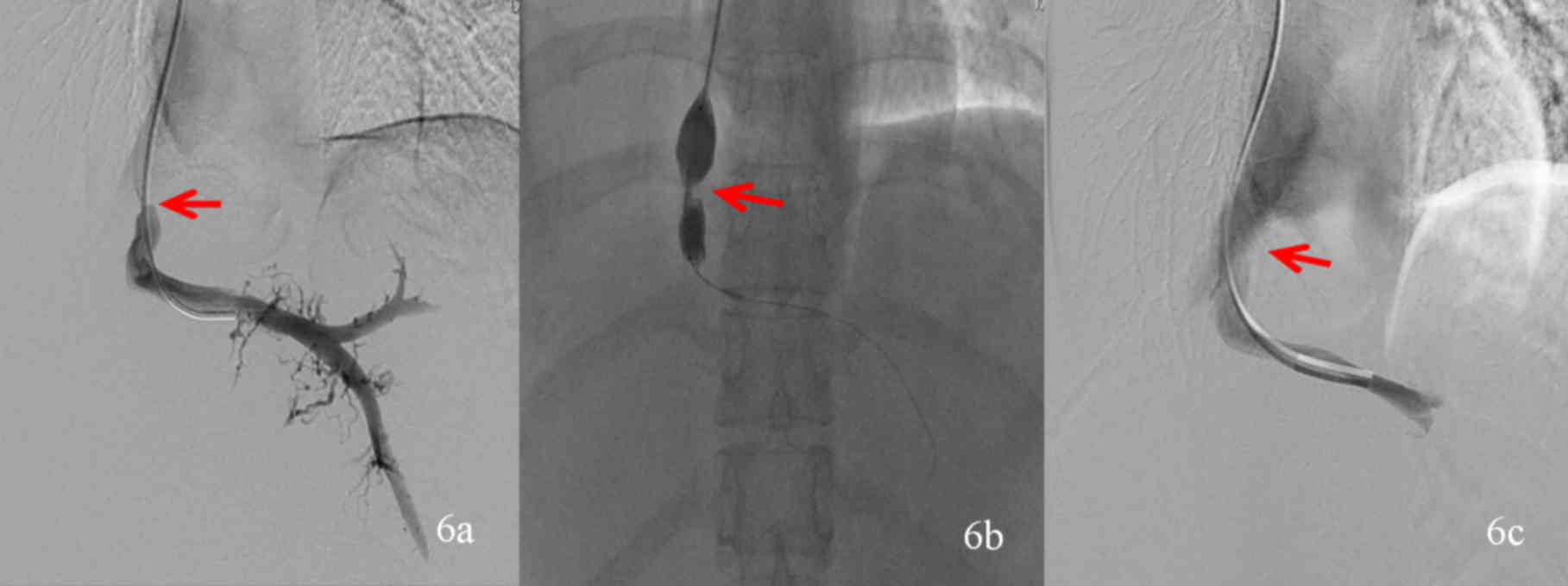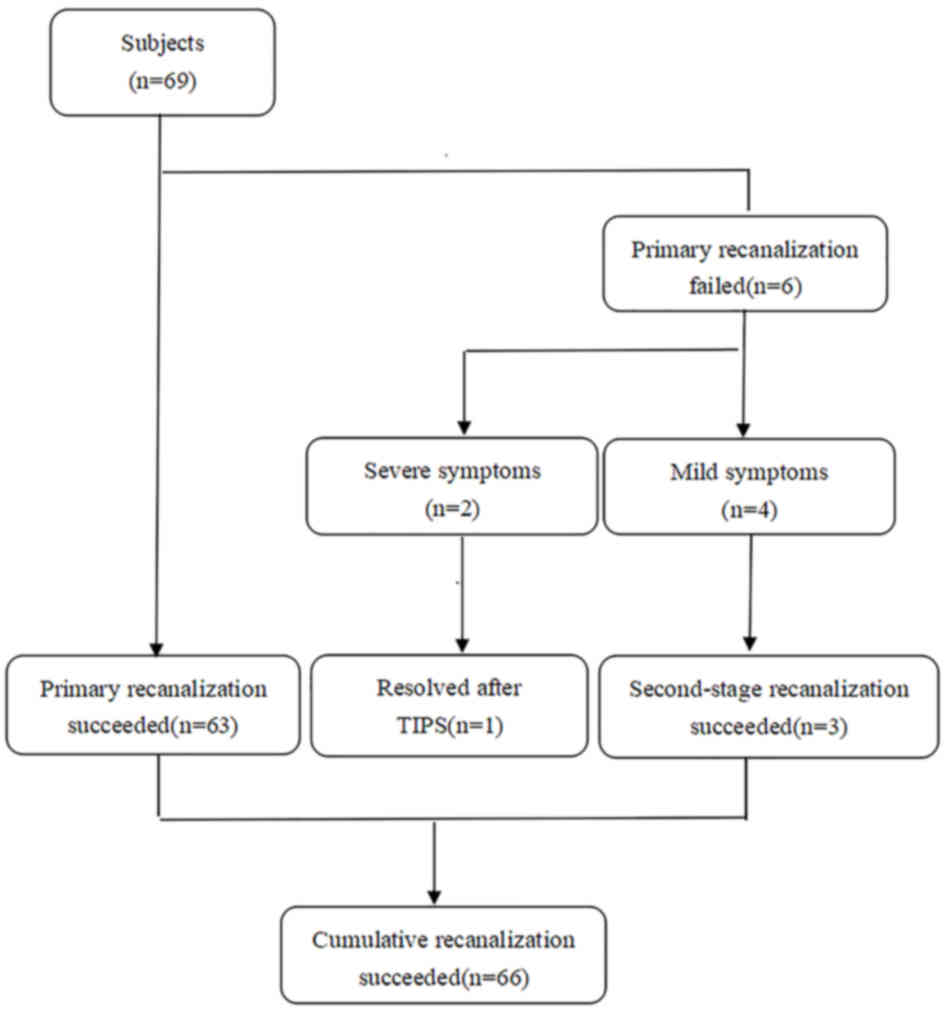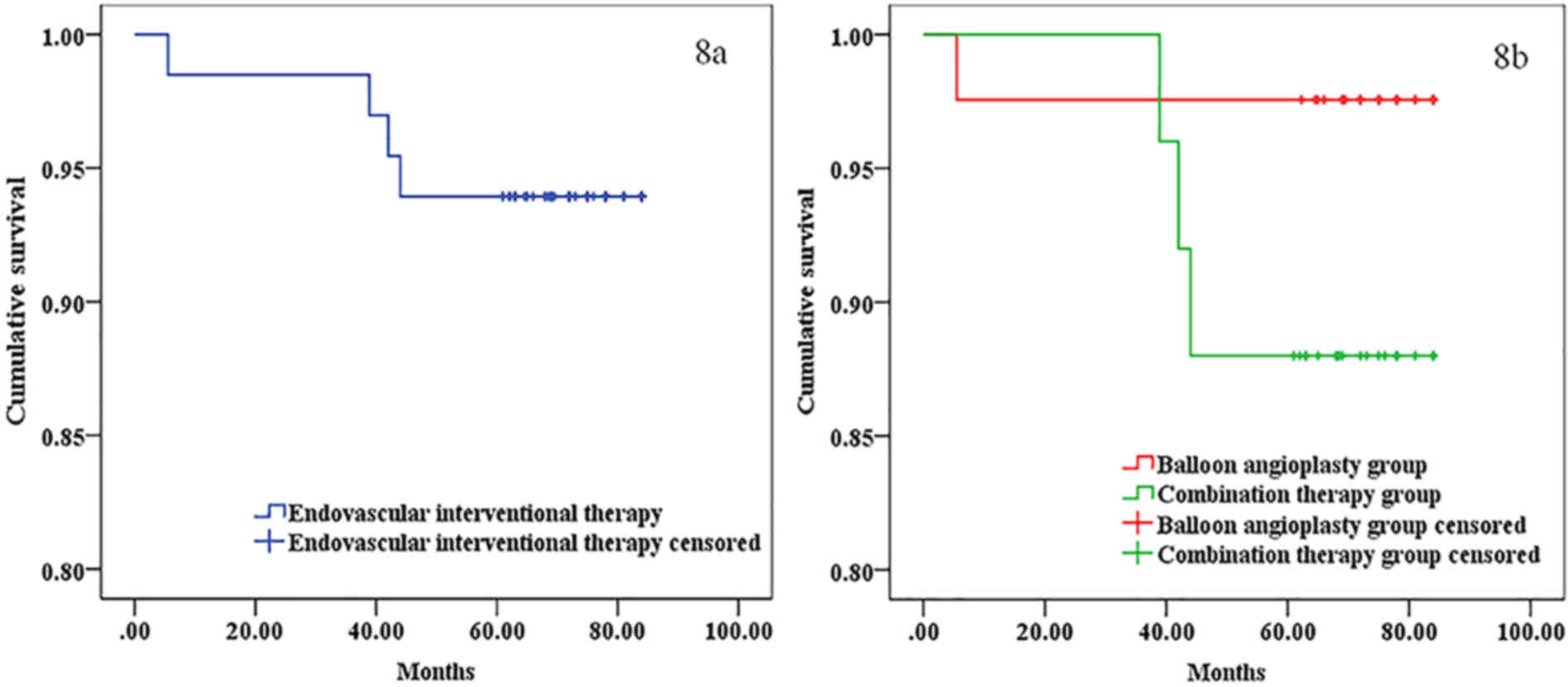|
1
|
Martens P and Nevens F: Budd-Chiari
syndrome. United European Gastroenterol J. 3:489–500. 2015.
View Article : Google Scholar : PubMed/NCBI
|
|
2
|
Shin N, Kim YH, Xu H, Shi HB, Zhang QQ,
Pons Colon JP, Kim D, Xu Y, Wu FY, Han S, et al: Redefining
Budd-Chiari syndrome: A systematic review. World J Hepatol.
8:691–702. 2016. View Article : Google Scholar : PubMed/NCBI
|
|
3
|
Goel RM, Johnston EL, Patel KV and Wong T:
Budd-Chiari syndrome: Investigation, treatment and outcomes.
Postgrad Med J. 91:692–697. 2015. View Article : Google Scholar : PubMed/NCBI
|
|
4
|
Cui YF, Fu YF, Li DC and Xu H:
Percutaneous recanalization for HV-type Budd-Chiari syndrome:
Long-term patency and survival. Hepatol Int. 10:363–369. 2016.
View Article : Google Scholar : PubMed/NCBI
|
|
5
|
Akamatsu N, Sugawara Y and Kokudo N:
Budd-Chiari syndrome and liver transplantation. Intractable Rare
Dis Res. 4:24–32. 2015. View Article : Google Scholar : PubMed/NCBI
|
|
6
|
Murad Darwish S, Plessier A,
Hernandez-Guerra M, Fabris F, Eapen CE, Bahr MJ, Trebicka J, Morard
I, Lasser L, Heller J, et al: Etiology, management, and outcome of
the Budd-Chiari syndrome. Ann Intern Med. 151:167–175. 2009.
View Article : Google Scholar : PubMed/NCBI
|
|
7
|
Sang HF and Li XQ: Endovascular treatment
of Budd-Chiari syndrome with HV obstruction in China. J
Laparoendosc Adv Surg Tech A. 24:846–851. 2014. View Article : Google Scholar : PubMed/NCBI
|
|
8
|
Seijo S, Plessier A, Hoekstra J, Dell'era
A, Mandair D, Rifai K, Trebicka J, Morard I, Lasser L, Abraldes JG,
et al: Good long-term outcome of Budd-Chiari syndrome with a
step-wise management. Hepatology. 57:1962–1968. 2013. View Article : Google Scholar : PubMed/NCBI
|
|
9
|
Fitsiori K, Tsitskari M, Kelekis A,
Filippiadis D, Triantafyllou K and Brountzos E: Transjugular
intrahepatic portosystemic shunt for the treatment of Budd-Chiari
syndrome patients: Results from a single center. Cardiovasc
Intervent Radiol. 37:691–697. 2014. View Article : Google Scholar : PubMed/NCBI
|
|
10
|
Tripathi D, Macnicholas R, Kothari C,
Sunderraj L, Al-Hilou H, Rangarajan B, Chen F, Mangat K, Elias E
and Olliff S: Good clinical outcomes following transjugular
intrahepatic portosystemic stent-shunts in Budd-Chiari syndrome.
Aliment Pharmacol Ther. 39:864–872. 2014. View Article : Google Scholar : PubMed/NCBI
|
|
11
|
Cheng D, Xu H, Lu ZJ, Hua R, Qiu H, Du H,
Xu X and Zhang J: Clinical features and etiology of Budd-Chiari
syndrome in Chinese patients: A single-center study. J
Gastroenterol Hepatol. 28:1061–1067. 2013. View Article : Google Scholar : PubMed/NCBI
|
|
12
|
Qi XS, Ren WR, Fan DM and Han GH:
Selection of treatment modalities for Budd-Chiari syndrome in
China: A preliminary survey of published literature. World J
Gastroenterol. 20:10628–10636. 2014. View Article : Google Scholar : PubMed/NCBI
|
|
13
|
Cui YF, Fu YF, Wei N, Zhu HC and Xu H:
Retrograde puncture assisted HV recanalization in treating
Budd-Chiari syndrome with segmental obstruction of hepatic venous.
Radiol Med. 120:1184–1189. 2015. View Article : Google Scholar : PubMed/NCBI
|
|
14
|
Kumar Shalimar A, Kedia S, Sharma H,
Gamanagatti SR, Gulati GS, Nayak B, Thakur B and Acharya SK:
Hepatic venous outflow tract obstruction: Treatment outcomes and
development of a new prognostic score. Aliment Pharmacol Ther.
43:1154–1167. 2016. View Article : Google Scholar : PubMed/NCBI
|
|
15
|
Meng X, Lv Y, Zhang B, He C, Guo W, Luo B,
Yin Z, Fan D and Han G: Endovascular management of Budd-Chiari
syndrome with IVC thrombosis: A 14-year single-center retrospective
report of 55 patients. J Vasc Interv Radiol. 27:1592–1603. 2016.
View Article : Google Scholar : PubMed/NCBI
|
|
16
|
Huang Q, Shen B, Zhang Q, Xu H, Zu M, Gu
Y, Wei N, Cui Y and Huang R: Comparison of long-term outcomes of
endovascular management for membranous and segmental IVC
obstruction in patients with primary Budd-Chiari syndrome. Circ
Cardiovasc Interv. 9:e0031042016. View Article : Google Scholar : PubMed/NCBI
|
|
17
|
Zhang Q, Xu H, Zu M, Gu Y, Wei N, Wang W,
Gao Z and Shen B: Catheter-directed thrombolytic therapy combined
with angioplasty for hepatic venous obstruction in Budd-Chiari
syndrome complicated by thrombosis. Exp Ther Med. 6:1015–1021.
2013. View Article : Google Scholar : PubMed/NCBI
|
|
18
|
Siriwardana RC, Niriella MA, Dassanayake
AS, Liyanage C, Gunathilaka B, Jayathunge S and de Silva HJ:
Clinical characteristics and outcome of hepatocellular carcinoma in
alcohol related and cryptogenic cirrhosis: A prospective study.
Hepatobiliary Pancreat Dis Int. 14:401–405. 2015. View Article : Google Scholar : PubMed/NCBI
|
|
19
|
Tang W, Zhang XM, Yang L, Mitchell DG,
Zeng NL and Zhai ZH: Hepatic caudate vein in Budd-Chiari syndrome:
Depiction byusing magnetic resonance imaging. Eur J Radiol.
77:143–148. 2011. View Article : Google Scholar : PubMed/NCBI
|
|
20
|
Mukund A and Gamanagatti S: Imaging and
interventions in Budd-Chiari syndrome. World J Radiol. 3:169–177.
2011. View Article : Google Scholar : PubMed/NCBI
|
|
21
|
Gao Y, Chen S and Yu C: Applicability of
different endovascular methods for treatment of refractory
Budd-Chiari syndrome. Cell Biochem Biophys. 61:453–460. 2011.
View Article : Google Scholar : PubMed/NCBI
|
|
22
|
Fan X, Liu K, Che Y, Wang S, Wu X, Cao J
and Li J: Good clinical outcomes in Budd-Chiari syndrome with
hepatic venous occlusion. Dig Dis Sci. 61:3054–3060. 2016.
View Article : Google Scholar : PubMed/NCBI
|
|
23
|
Hanaoka J, Shimada M, Uchiyama H, Ikegami
T, Imura S, Morine Y and Kanemura H: A simple formula to calculate
the liver drainage volume of the accessory right HV using its
diameter alone. Surgery. 146:264–268. 2009. View Article : Google Scholar : PubMed/NCBI
|
|
24
|
Miraglia R, Maruzzelli L and Luca A:
Recanalization of occlusive transjugular intrahepatic portosystemic
shunts inaccessible to the standard transvenous approach. Diagn
Interv Radiol. 19:61–65. 2013.PubMed/NCBI
|
|
25
|
Gupta AC, Wang W, Shah C, Sands MJ, Bullen
J, Remer EM, Bayona PM, Carey W and Kapoor B: Added value of
covered stents in transjugular intrahepatic portosystemic shunt: A
large single-center experience. Cardiovasc Intervent Radiol.
40:1723–1731. 2017. View Article : Google Scholar : PubMed/NCBI
|
|
26
|
Eapen CE, Velissaris D, Heydtmann M,
Gunson B, Olliff S and Elias E: Favourable medium term outcome
following hepatic vein recanalisation and/or transjugular
intrahepatic portosystemic shunt for Budd Chiari syndrome. Gut.
55:878–884. 2006. View Article : Google Scholar : PubMed/NCBI
|
|
27
|
Valla D, Hadengue A, el Younsi M, Azar N,
Zeitoun G, Boudet MJ, Molas G, Belghiti J, Erlinger S, Hay JM and
Benhamou JP: Hepatic venous outflow block caused by short-length
hepatic vein stenoses. Hepatology. 25:814–819. 1997. View Article : Google Scholar : PubMed/NCBI
|



